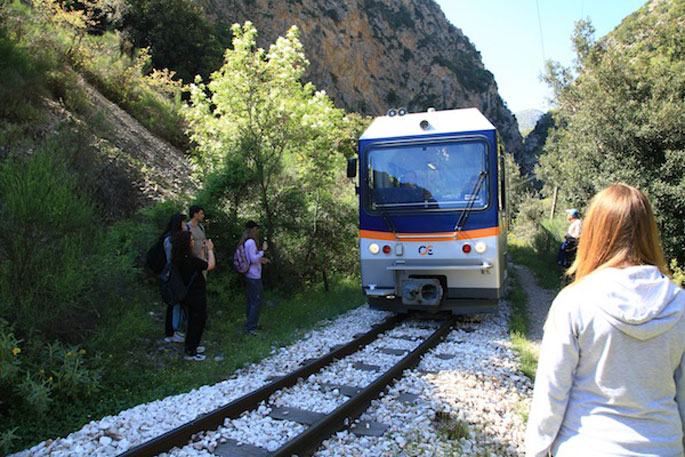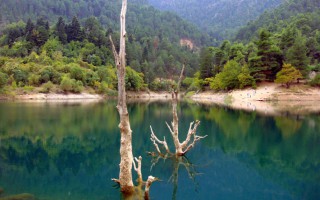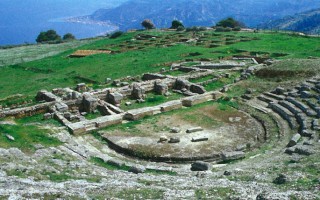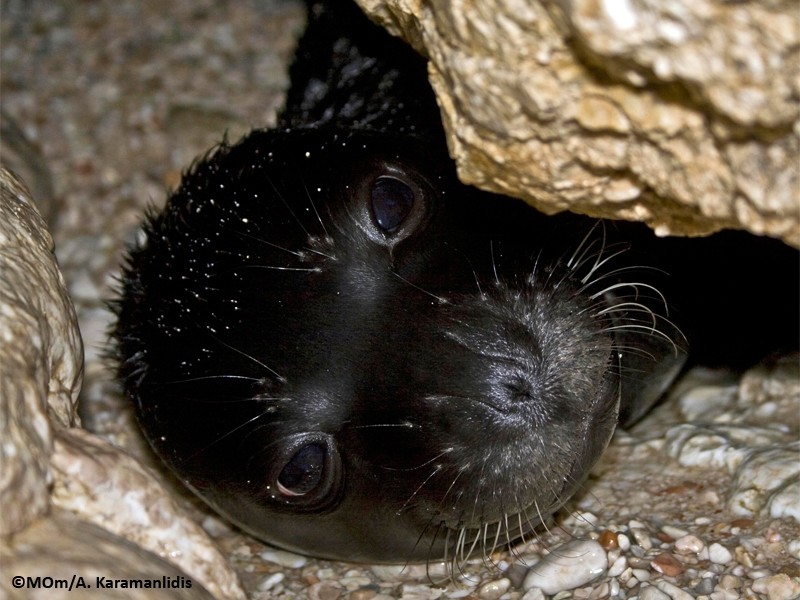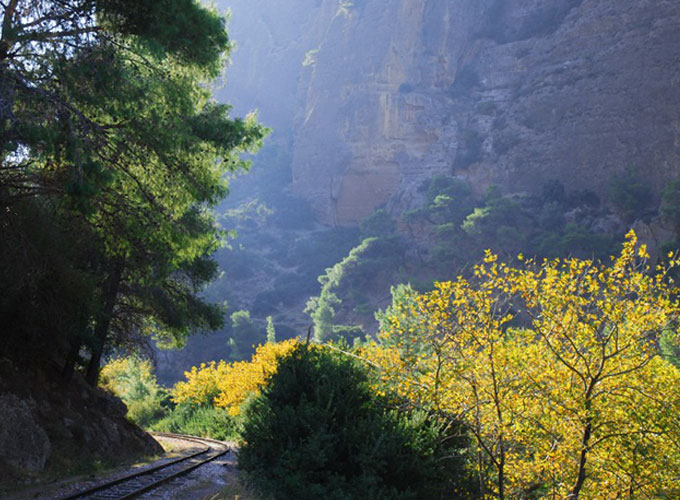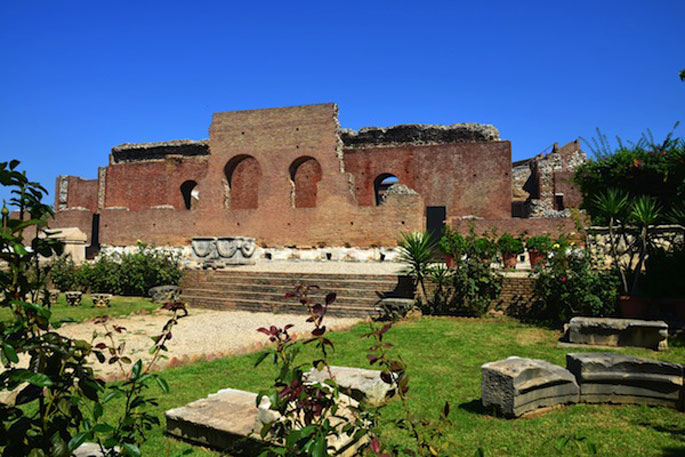We start our presentation with two “Twelve Months’” cities, vigorously active throughout the year: Athens and Thessaloniki, in Attica and in Central Macedonia. Two cities where one can enjoy the holidays of winter and the New Year, spring, summer, all seasons… Two cities with events, festivals, short routes to nature and to major attractions…
Take a look at the “Twelve Points” that you should not fail to see in Athens and Thessaloniki!
 In 1889, Charilaos Trikoupis, Greece’s Prime Minister at the time, decided to construct the rack railway. Specialized technicians from France and Italy undertook the construction of the track and it lasted seven years.
In 1889, Charilaos Trikoupis, Greece’s Prime Minister at the time, decided to construct the rack railway. Specialized technicians from France and Italy undertook the construction of the track and it lasted seven years.
King George I was the first train passenger that took the first journey on March 10th, 1896. The purpose of the railway was to connect the region of Kalavryta to Athens and Patras since there was no other means of easy access.
 The railway track is 22 km long and it connects Kalavryta and Diakopto. It has the narrowest gauge in Europe, 0,75m.
The railway track is 22 km long and it connects Kalavryta and Diakopto. It has the narrowest gauge in Europe, 0,75m.
The train has an average speed of 30-40km per hour and the journey takes approximately one hour.
Due to the large inclination, the track has several toothed parts.
Half way from Diakopto to Kalavryta the train stops to Niamata, Triklia, Zachlorou and Kerpini. The journey along the Vouraikos gorge is magic. You can organize an excursion with stopovers. Visitors can, for example, stop at the Zachlorou station and walk to the imposing monastery of Mega Spilaio.
Source: www.mythicalpeloponnese.gr
 MOm/ The Hellenic Society for the Study and Protection of the Monk seal is a Greek non–governmental environmental organization with the legal status of a Non–profit association. MOm is active in the protection and promotion of the coastal and marine environment of Greece, through the protection of the Mediterranean monk seal, which is the only seal species in the Mediterranean Sea and the most endangered seal on earth.
MOm/ The Hellenic Society for the Study and Protection of the Monk seal is a Greek non–governmental environmental organization with the legal status of a Non–profit association. MOm is active in the protection and promotion of the coastal and marine environment of Greece, through the protection of the Mediterranean monk seal, which is the only seal species in the Mediterranean Sea and the most endangered seal on earth.
The financial resources of MOm originate from the memberships of our supporters, donations from private entities, selected partnerships with national, European and international bodies, and from nationally and European-funded programs. MOm is subject to regular financial auditing by Certified Public Accountants – Auditors.
 The main goal of MOm/ Hellenic Society for the Study and Protection of the Monk Seal is the conservation of the natural environment and the biodiversity of Greek seas, through the protection of the critically endangered Mediterranean monk seal (Monachus monachus). MOm strives for the survival of the only seal species in the Mediterranean Sea and for a healthy marine environment for the present and future generations!
The main goal of MOm/ Hellenic Society for the Study and Protection of the Monk Seal is the conservation of the natural environment and the biodiversity of Greek seas, through the protection of the critically endangered Mediterranean monk seal (Monachus monachus). MOm strives for the survival of the only seal species in the Mediterranean Sea and for a healthy marine environment for the present and future generations!
In order to achieve the above, MOm works tirelessly on two different, but highly related fronts. Our aim is to:
• Reduce human – related monk seal mortality
• Preserve the last remaining habitat for the critically endangered Mediterranean monk seal
Important Areas
The largest population of the critically endangered Mediterranean monk seal lives in Greece and is estimated to number approximately 300 individuals. Monk seals are widely distributed throughout the entire coastline of the country and show a strong preference for isolated and inaccessible islands, islets or parts of the coastline on the mainland. The largest and most closely monitored populations are those at the Northern Sporades Islands and at the Kimolos – Polyaigos island complex. The population at the Northern Sporades Islands (which includes the National Marine Park of Alonissos, Northern Sporades) has been closely monitored by MOm since 1988 and is considered to number more than 50 individuals. Another 50 individuals are also believed to live at the Kimolos – Polyaigos island complex in the southwestern Cyclades islands. Important reproductive populations of the species can also be found at the islands of Northern Karpathos and Saria (this population is estimated to number approximately 25 individuals) and at the Ionian Islands (i.e., Zakynthos and Cephalonia). In recent years, the largest population of Mediterranean monk seals in Greece was discovered at the island of Gyaros, in the northern Cyclades Islands, and has been estimated to number approximately 60 individuals.
Studying the distribution of the Mediterranean monk seal in Greece is conducted mainly through the evaluation and mapping of information received by the Hellenic Rescue and Information Network of MOm (RINT) and through the collection of on-site information during the monitoring of important monk seal populations in the country.
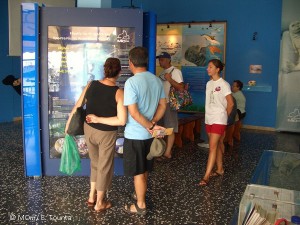 Environmental Education
Environmental Education
Environmental education is one of the most useful tools in the effective conservation of the natural environment, and is therefore also a cornerstone of MOm’s activities. MOm carries out environmental education activities throughout Greece with a special focus on coastal and insular areas. The goal is to educate school children, our future generation, about the critically endangered status of the Mediterranean monk seal and its habitat and how they can become active in their protection. This is done by challenging their learning process and their critical thinking. The environmental education programs of MOm have been officially approved by the Hellenic Ministry of Education and have been attended so far by more than 250,000 school children in the country.
Furthermore, each year MOm carries out during the summer months the environmental program “The school of the monk seal”. At the Information Center of MOm at the island of Alonissos young children learn about environmental protection through a variety of interactive activities, such as theatrical plays, treasure hunts etc. The Environmental Center has also a children’s library with more than 1,300 different books.
Acknowledging the increasing role of the internet in the education process, MOm has also developed several educational websites:
• www.monachoulis.gr. This is the main environmental education website of MOm, containing information about the Mediterranean monk seal and the environmental education material of MOm. The target group of the site are school children but also teachers seeking to enrich their curriculum with information regarding the protection of the Mediterranean monk seal and the marine environment in general.
• www.thalassapedia.gr/en/. This website was created within the framework of the European program Life “Thalassa” and contains information regarding the marine mammals in Greece, the threats they face and ways to help save them.
• http://mofi.mom.gr/ekpaideysi.htm: This is the educational outlet of the project MOFI that was carried out by MOm in 2006 – 2009 throughout coastal and insular Greece with the aim of mitigating monk seal – fishery conflicts. This website contains a link to a book on sustainable fisheries.
If you want to learn more about the environmental education programs of MOm, please contact MOm by phone at +30 210 5222888 or by email at info@mom.gr.
Vouraikos gorge starts at a distance of 3 km from the west foothills of mount Helmos and mount Panachaiko, and leads all the way to Diakopto. Vouraikos River springs from the mountains of Kalavryta and ends at the Corinthian gulf, near the beach of Diakopto. Along its way it has created a deep, unique gorge.
 As it runs down to the sea, it receives the waters of several streams forming small lakes and numerous cascades. Its width is constantly changing. The narrowest spot, “Portes”, is located close to Zachlorou. According to the myth, there was a rock there, blocking Hercules passage. Hercules cut the rock in two and created this gateway. The rack railway passes through the gorge.
As it runs down to the sea, it receives the waters of several streams forming small lakes and numerous cascades. Its width is constantly changing. The narrowest spot, “Portes”, is located close to Zachlorou. According to the myth, there was a rock there, blocking Hercules passage. Hercules cut the rock in two and created this gateway. The rack railway passes through the gorge.
The region is protected under the European Natura 2000 due to its abundant flora and fauna.
Source: www.mythicalpeloponnese.gr
 Kalavryta Ski resort is situated 14km from the town, at an altitude of 1670 to 2328 meters above sea level, on the southern side of mount Helmos.
Kalavryta Ski resort is situated 14km from the town, at an altitude of 1670 to 2328 meters above sea level, on the southern side of mount Helmos.
It has 8 lifts, 2 aerial (1 three-seat and 1 two-seat), 3 drag lifts (one of them double), 2 lifts for children and a recreation one. The biggest lift is 1415m long and has a height difference of 472m. The total lift capacity is 5.000 people per hour.
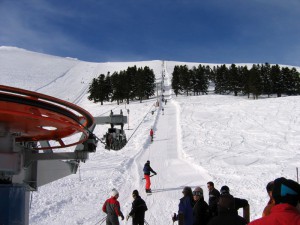 The resort offers 11 runs, of which two are really easy runs, adequate for beginners. The runs cover all grades of difficulty and all levels of capacity. The runs’ length varies between 165m and 3210m. The Ski International Federation has allowed the organization of competitions in several runs of Kalavryta Ski Resort.
The resort offers 11 runs, of which two are really easy runs, adequate for beginners. The runs cover all grades of difficulty and all levels of capacity. The runs’ length varies between 165m and 3210m. The Ski International Federation has allowed the organization of competitions in several runs of Kalavryta Ski Resort.
There are also special runs for cross country ski, Nordic ski trails and walking and climbing paths.
In the resort there are reception buildings, where skiers and visitors can rest, have coffee or eat.
Visitors will also find spacious parking areas and a first aid station, ski rental facilities and ski schools.
More than 100,000 people come here every year to enjoy the snow.
Source: www.mythicalpeloponnese.gr
 One of the few lakes in the mountainous region of the Peloponnese, lake Tsivlou is situated at an altitude of 800 m. It was formed following a landslide in 1912 when the ancient river Krathis was blocked.
One of the few lakes in the mountainous region of the Peloponnese, lake Tsivlou is situated at an altitude of 800 m. It was formed following a landslide in 1912 when the ancient river Krathis was blocked.
The small yet picturesque lake is located half way from Akrata to Zarouchla. Enjoy a picnic with view the huge branches sprouting out of its surface or chose between walking, mountain biking and off-road rides along the trail surrounding the lake.
Source: www.mythicalpeloponnese.gr
 The ancient theater is situated near the town of Aigeira at an altitude of 350m above sea level offering a view to the Corinthian gulf. Its construction dates back to 280-250 Β.C. Similar to the orchestra, the koilo is hewn on natural rock and when not available the soil was cut to accommodate stone seats. During the Hellenistic period it consisted of a two storey building. A corridor divides the koilo into two parts with a total capacity of 3000 spectators, its total length reaching 30,70 m.
The ancient theater is situated near the town of Aigeira at an altitude of 350m above sea level offering a view to the Corinthian gulf. Its construction dates back to 280-250 Β.C. Similar to the orchestra, the koilo is hewn on natural rock and when not available the soil was cut to accommodate stone seats. During the Hellenistic period it consisted of a two storey building. A corridor divides the koilo into two parts with a total capacity of 3000 spectators, its total length reaching 30,70 m.
Source: www.mythicalpeloponnese.gr
Patra, the capital of the prefecture of Achaea, is without doubt a city with great history and many interesting places for one to discover during a visit. However to the majority of the people the city is best known for its Carnival, which, is, admittedly, the biggest and most impressive carnival out of the dozens that are organized in various areas in Greece.
The Carnival of Patra began in the 19th century and has many western influences, which were transferred to the mainland via the Ionian islands. Nevertheless, the ancient roots of the Carnival cannot be disputed; it was connected with pagan traditions and rituals, especially the ecstatic celebrations in honour of Dionysus, who was the god of ecstasy and inebriation, and also of the rebirth of nature.
The Carnival opens every year on January 17, it reaches, however, its height during the final weekend of the Carnival, before Clean Monday, when the great parade also takes place. These days are filled with non-stop partying, vibrant colours, music, dancing and feasting until the small hours, with the participation of everyone, young and old, from all over the county.
Patra is a vibrant city year-round; during the Carvival, however, it becomes even more alive, giving the impression that the whole of Greece has gathered here. Every year, when the Carnival ends, with the burning of the Carnival King, preparations for the next one essentially begin. Officially, though, the Carnival begins on January 17 and lasts until Clean Monday. On the name day of Aghios Antonios, the public crier goes around the city inviting everyone to gather in the evening at the central square, Plateia Georgiou; there, during a spectacular ceremony, the Mayor of Patra signals the official opening of the Carnival. During the period before the big parade, the city slowly dons its official, colourful costume, puts on its garlands and confetti, rehearses its songs, counts its dance steps, lets the hooters and the whistles accompany it and treats the people copious amounts of mavrodafni. The Carnival of Patra is the greatest carnival celebration in Greece and has a long history of 181 years. Its beginning was signalled by the first masquerade ball after the liberation, thrown in 1829 in the house of the merchant Morettis. Its beginning seems also to be connected to the French troops of general Maison, which settled temporarily in the city after the liberation from the Turks and it is considered that they passed on their homeland’s carnival traditions to the locals. The Eptanisians, also, are said to have contributed significantly to the development of the carnival tradition: After the unification of the Ionian Islands with Greece in 1864, many of them arrived in Patra, where it is believed they influenced the carnival celebrations, complementing them with their homeland’s special colour. Let’s not forget, of course, Patra’s strategic location, with its ever-developing port, which allowed it to have constant liaisons with the West and especially Italy, home to many marvellous carnivals (the famous Carnival of Venice): because of its location, the city played an important role in shaping the Carnival tradition. The first carnival floats appeared during the 1870s, with creations initially taken up exclusively by individuals. In 1966 the Carnival took a new form, with the incorporation of the Treasure Hunt custom, and the carnival celebrations began being broadcast by the Hellenic Broadcasting Corporation (ERT). In 1974 the street parade was also incorporated.
The events
Tsiknopempti (“grilling day”)
This day is the joy of the gourmand, since hundreds of locals set up makeshift grills in every part of the city. The events, however, revolve around the upper part of the city and mainly Germanou street and the streets around it, where the folk traditions revive. Traditional carnival events, music groups and a festive and authentically satirical mood complete this night, with its large meat and wine consumption.
 The Children’s Carnival
The Children’s Carnival
The Children’s Carnival is a separate and significant chapter of the Carnival of Patra. For 17 consecutive years, having sealed a mutual relationship of trust with its young friends, it continues to provide them the opportunity to experience new things and to immerse themselves creatively in the cultural events, amidst fun and games, and also to develop their senses, imagination and freedom of expression through alternative forms of art. Its main activities are the Carnival Workshop, the Carnival Cities, theatre performances and musical events, exhibitions and, of course, the Great Children’s Parade.
The Treasure Hunt
The Treasure Hunt began 47 years ago and is an important component of the Carnival of Patra’s success. The Treasure Hunt groups are formed either from the groups that participate in the Carnival’s Big Parade, or from pupils of the city’s schools, colleagues from work or neighbours. The Treasure Hunt includes riddles, as well as navigation tasks carried out through hidden clues, scattered all across the city.
 The Bourboulia
The Bourboulia
The Bourboulia is an exclusive local custom you will not come across anywhere else in Greece. It is considered, moreover, one of the oldest carnival customs, its beginnings dating back to the 19th century, possibly to the time when the Apollon Theatre was built in Patra, in 1872, by the architect Ernst Ziller. The Bourboulia are afternoon dances where the men go undisguised while the women wear dominoes and disguise their identity behind a mask. In this way, they can choose their dancing partner without revealing who they are. The Bourboulia were introduced at a time when there were stricter codes regarding the relations between the sexes; these dances provided a temporary respite to this strictness, giving the people the opportunity to interact without the fear of scandal.
Other games
Apart from the aforementioned, many other activities take place around the city, such as painting, pantomime and theatre trivia competitions, as well as anything the Carnival organizers might come up with. At the same time, some teams participate in the parade with a float they have built themselves, whose theme is relevant to their costume. The participants experience the fascinating magic and the strong emotions associated with a game of joy, fun and pursuit with many surprises, twists and unexpected events.
Source: www.mythicalpeloponnese.gr
Erected before the Odeum of Herodes Atticus in Athens, the Roman Odeum of Patras was built in 160 BC. According to Pausanias, it has the most beautiful decoration after that the Odeum of Athens. On site was the statue of Apollo, which was built from the spoils of war between the Aitolians and the Gauls. In 279 B.C., the inhabitants of Patras created an alliance with the Aitolians to win the war.
Completely covered with earth until then, the Odeum was revealed in 1889. The monument was repaired and dressed again with marble slabs after World War II.
The cavea has four rows of seats in the lower section, and seven in the upper part, over the diazoma. The outer, tall wall of the stage (skene) has five entrances to the skene and the lateral buildings (paraskenia). The orchestra is paved and separated from the cavea by a semicircular parapet.
Source: www.mythicalpeloponnese.gr
 To the west of the prefecture of Ilia, 27 km from its capital, Pyrgos, lies the area known as Kaiafas, comprising a vast beach on the side of the Ionian sea, a coastal pine forest and the homonymous lake, which is the centre of health tourism in the area. The healing properties of the Kaiafa lake waters have been known since antiquity; according to the ancient Greeks, they owed their properties to the nymphs who inhabited the forests surrounding the area. For that reason they honoured them with great piety, erecting splendid temples and sanctuaries in their name. Those visiting Kaiafas today do so not only for the water therapy, but also to admire the unique natural landscape and to do activities such as sea sports, which are offered in the area. The beautiful, serene nature also sets the scene for total relaxation, away from the city’s rapid pace.
To the west of the prefecture of Ilia, 27 km from its capital, Pyrgos, lies the area known as Kaiafas, comprising a vast beach on the side of the Ionian sea, a coastal pine forest and the homonymous lake, which is the centre of health tourism in the area. The healing properties of the Kaiafa lake waters have been known since antiquity; according to the ancient Greeks, they owed their properties to the nymphs who inhabited the forests surrounding the area. For that reason they honoured them with great piety, erecting splendid temples and sanctuaries in their name. Those visiting Kaiafas today do so not only for the water therapy, but also to admire the unique natural landscape and to do activities such as sea sports, which are offered in the area. The beautiful, serene nature also sets the scene for total relaxation, away from the city’s rapid pace.
 Kaiafas, with its lake and the unique natural landscape that surrounds it, is located on the border with the Municipality of Zacharo and comprises the huge, sandy coast traversing the entire coastal line of the bay of Kyparissia, the impressive pine forest of Strofilia, the plain of Xirochori-Zacharo and the mountain range of the mythical mountain Lapithas, on the western foot of which lies the spring of the Anigrides nymphs and on its eastern foot the spring of Geranios.The warm, healing waters of the lake are considered suitable for skin conditions, rheumatism, various conditions of the liver and asthma, and have many times been exalted by those who tried water therapy as a solution to one of the aforementioned problems. The belief in their healing properties is an ancient one; according to Pausanias, the cave that lies to the area’s west, called “the cave of the Anigrides nymphs”, was inhabited by the nymphs Kalliafeia, Pigaia and Iasis. From the first one derives the name of the area today, Kaiafas, while the names of the other two testify to the existence of healing waters (pigi = spring, iasis = cure). According to myth, Dardanos, the ancestor of the Trojans, was born in the Anigrides cave. It is also said that in this spring the Centaur Nessos washed his wounds; he had been hit by the poisonous arrows of Hercules, which explains the waters’ foul smell.
Kaiafas, with its lake and the unique natural landscape that surrounds it, is located on the border with the Municipality of Zacharo and comprises the huge, sandy coast traversing the entire coastal line of the bay of Kyparissia, the impressive pine forest of Strofilia, the plain of Xirochori-Zacharo and the mountain range of the mythical mountain Lapithas, on the western foot of which lies the spring of the Anigrides nymphs and on its eastern foot the spring of Geranios.The warm, healing waters of the lake are considered suitable for skin conditions, rheumatism, various conditions of the liver and asthma, and have many times been exalted by those who tried water therapy as a solution to one of the aforementioned problems. The belief in their healing properties is an ancient one; according to Pausanias, the cave that lies to the area’s west, called “the cave of the Anigrides nymphs”, was inhabited by the nymphs Kalliafeia, Pigaia and Iasis. From the first one derives the name of the area today, Kaiafas, while the names of the other two testify to the existence of healing waters (pigi = spring, iasis = cure). According to myth, Dardanos, the ancestor of the Trojans, was born in the Anigrides cave. It is also said that in this spring the Centaur Nessos washed his wounds; he had been hit by the poisonous arrows of Hercules, which explains the waters’ foul smell.
This hydrotherapy centre is responsible for attracting many tourists in the area, of all ages and from all over the world. The healing waters are rich in hydrogen sulphide and their temperature remains stable at 20-30 °C between May and October, which is the most suitable period for water therapy.
Kaiafas, of cource, isn’t good only for water therapy; many also come here to enjoy the enchanting landscape, with the emerald-green sea, the beach with the sand dunes and the unique vegetation surrounding the lake. It is not a coincidence that the lake has been declared a protected area. At its centre lies the islet of Aghia Ekaterini, with the small church of the same name and the Tourism Development Company’s building facilities, which include, among others, hotels and lodgings. The islet and the opposite coast are linked by a bridge, while the transition from the hydrotherapy centre to the hotel facilities and the reverse is done by boat.
For those who wish to get to know the surrounding area, there are various points of interest, such as the beaches of Kourouta and Zacharo and also other, lesser known beaches, a short distance away by car. No matter what you choose to do, it is certain that your stay in the Kaiafas area will regale you with unique images and offer you moments of complete relaxation.
Source: www.mythicalpeloponnese.gr




